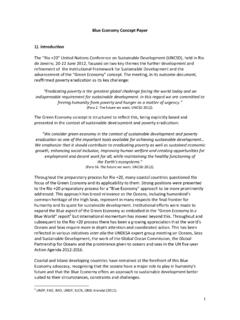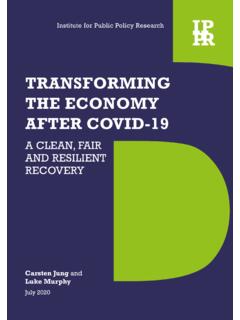Transcription of EU green bond standard usability guide
1 usability guide . TEG PROPOSAL FOR AN EU green bond standard . - 1- March 2020. introduction Context and background information In March 2018, the european commission (EC) published its Action Plan on Financing Sustainable Growth (Action Plan) which set out a comprehensive strategy to further connect finance with sustainability. In Action 2 of the Action Plan, the EC committed to create standards and labels for green financial products. In June 2018, the EC set up a Technical Expert Group on sustainable finance (TEG) comprising 35 members from civil society, academia, business and the finance sector, as well as 10 additional members and observers from the european Union (EU) and international public bodies.
2 The TEG included four work areas developing recommendations for: an EU classification system the so-called EU Taxonomy to determine whether an economic activity is environmentally sustainable;. an EU green bond standard ;. methodologies for EU climate benchmarks and disclosures for benchmarks; and guidance to improve corporate disclosure of climate-related information. The TEG published its interim report on an EU green bond standard (EU GBS) in March 2019 for public feedback. After evaluation of the feedback, the TEG published its final report in June 2019 with recommendations to the EC on principles as well as a draft model of an EU GBS (TEG EU GBS.)
3 Report)1. The TEG proposes that any type of listed or unlisted bond or capital market debt instrument issued by a european or international issuer that is aligned with the EU GBS should qualify as an EU. green bond . The proposed draft model links the use-of-proceeds of EU green Bonds to the EU Taxonomy Regulation2, which set up a classification system for environmentally sustainable economic activities. Under the EU Taxonomy Regulation, for an economic activity to be considered environmentally sustainable it has to (i) substantially contribute to one of the six environmental objectives determined under the EU Taxonomy Regulation, (ii) do no significant harm to any of the other environmental objectives, (iii) be carried out in compliance with minimum safeguards and (iv) comply with technical screening criteria.
4 When the TEG EU GBS report was published in June 2019, the EU Taxonomy Regulation was still in negotiation. In December 2019, the european Parliament and the Council reached a political agreement on this proposal. In light of this political agreement, the TEG has amended the draft model of an EU GBS to reflect the latest agreement (Annex 1). One of the major changes relates to the expanded definition of minimum safeguards that activities have to comply with in order to qualify as environmentally sustainable. In the political agreement, the minimum safeguards were extended to 1. 2. Political Agreement reached by EU co-legislators on 17 December 2019 on a Proposal for a Regulation of the european Parliament and of the Council on the establishment of a framework to facilitate sustainable investment 2018/0178 (COD), see: unified-eu-classification-system/.
5 - 2- include alignment with the OECD Guidelines for Multinational Enterprises and UN Guiding Principles on Business and Human Rights. In December 2019, the EC also presented the european green Deal 3, an overarching framework and programme of actions for making the EU's economy sustainable. The european green Deal resets the EC's commitment to tackling climate and environment-related challenges and it emphasises the key role the private sector will have to finance the green transition. It recognizes the EU Taxonomy as an important aspect and it also includes the potential development of an EU green bond standard .
6 Moreover, in December 2019 the european commission 's Joint Research Centre (JRC) published a draft proposal for the EU Ecolabel criteria for retail financial products 4. The JRC's proposal suggests that the EU Ecolabel not be awarded to a financial product itself but to the financial service being provided by the manufacturer of the green financial product. The JRC recommends that the manufacturers of financial products use the EU GBS to demonstrate alignment with the taxonomy of the underlying components of their financial products ( , green bonds included in a bond fund carrying the EU Ecolabel).
7 In February 2020, the european Securities and Market Authority (ESMA). published its Strategy on Sustainable Finance 5. ESMA lays out its key role in supporting the transition of the financial system by reorienting private capital to more sustainable investments, fostering more transparency and long-termism in the economy . In this document, ESMA clarifies its willingness to accept new supervisory mandates, if requested, such as for example in relation to the european green Bonds standard 6. In March 2020 the Final report of the Technical Expert Group on Sustainable Finance for the EU. Taxonomy7 (TEG Taxonomy report) is being published, setting out the TEG's final recommendations for the EC.
8 The TEG Taxonomy report contains recommendations to the overarching design of the EU Taxonomy as well as guidance for its users. In addition to the summary of the economic activities covered by the technical screening criteria, the TEG Taxonomy report is supplemented by a technical annex containing a full list of technical screening criteria for economic activities which can substantially contribute to climate change mitigation or adaptation. Additional technical screening criteria for the four remaining environmental objectives (sustainable use and protection of water and marine resources; transition to a circular economy ; pollution prevention and control; and protection and restoration of biodiversity and ecosystems) will be developed by the Platform on Sustainable Finance in the next 20 months8.
9 This EU green bond standard usability guide ( guide ) offers recommendations from the TEG, with its views on the practical application of the EU GBS, as it was described by the TEG EU GBS report. This guide aims to support potential issuers, verifiers and investors of EU green Bonds. It provides guidance reflecting the latest changes in the draft model of the EU GBS. As described in the TEG EU. GBS report, the TEG proposes that the use of EU GBS remains voluntary. Issuers of green bonds 3. 4. 5. 6. Idem, p. 8. 7. 8. The Platform on Sustainable Finance is multi-stakeholder platform of experts convened by the european commission as mandated by Article 15 of the EU Taxonomy Regulation.
10 - 3- that do not want to use the term EU green bond ' and prefer opting for other market practices are not obliged to follow the four components of the EU GBS. Outlook The EC is planning to hold a public consultation for three months from mid-March. This will form the basis for the Renewed Sustainable Finance Strategy that will be presented in the third quarter of 2020. as announced in the european green Deal. Part of the consultation will be dedicated to a possible legislative initiative on an EU green bond standard . The draft model of the EU GBS, developed by the TEG, will form the basis of the consultation.
















